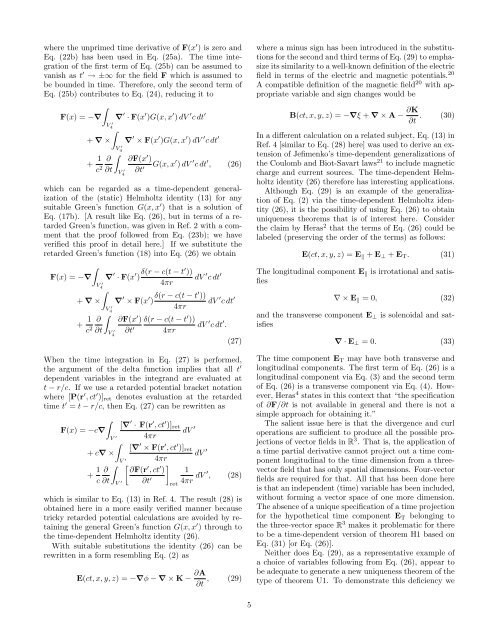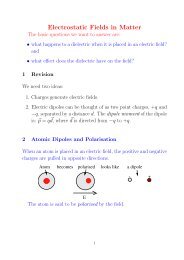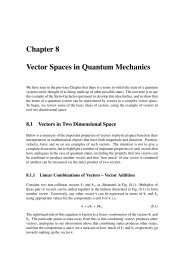Three-vector and scalar field identities and uniqueness theorems in ...
Three-vector and scalar field identities and uniqueness theorems in ...
Three-vector and scalar field identities and uniqueness theorems in ...
Create successful ePaper yourself
Turn your PDF publications into a flip-book with our unique Google optimized e-Paper software.
where the unprimed time derivative of F(x ′ ) is zero <strong>and</strong> where a m<strong>in</strong>us sign has been <strong>in</strong>troduced <strong>in</strong> the substitutionsE(ct, x, y, z) = −∇φ − ∇ × K − ∂A∂t , (29) be adequate to generate a new <strong>uniqueness</strong> theorem of thetype of theorem U1. To demonstrate this deficiency weEq. (22b) has been used <strong>in</strong> Eq. (25a). The time <strong>in</strong>tegrationfor the second <strong>and</strong> third terms of Eq. (29) to empha-of the first term of Eq. (25b) can be assumed tovanish as t ′ → ±∞ for the <strong>field</strong> F which is assumed tobe bounded <strong>in</strong> time. Therefore, only the second term ofEq. (25b) contributes to Eq. (24), reduc<strong>in</strong>g it tosize its similarity to a well-known def<strong>in</strong>ition of the electric<strong>field</strong> <strong>in</strong> terms of the electric <strong>and</strong> magnetic potentials. 20A compatible def<strong>in</strong>ition of the magnetic <strong>field</strong> 20 with appropriatevariable <strong>and</strong> sign changes would be∫F(x) = −∇ ∇ ′ · F(x ′ )G(x, x ′ ) dV ′ c dt ′B(ct, x, y, z) = −∇ξ + ∇ × A − ∂K∂t . (30)V 4∫′+ ∇ × ∇ ′ × F(x ′ )G(x, x ′ ) dV ′ c dt ′ In a different calculation on a related subject, Eq. (13) <strong>in</strong>Ref. 4 [similar to Eq. (28) here] was used to derive an extensionof Jefimenko’s time-dependent generalizations ofV 4′+ 1 ∫∂ ∂F(x ′ )c 2 ∂t V 4′ ∂t ′ G(x, x ′ ) dV ′ c dt ′ , (26) the Coulomb <strong>and</strong> Biot-Savart laws 21 to <strong>in</strong>clude magneticcharge <strong>and</strong> current sources. The time-dependent Helmholtzidentity (26) therefore has <strong>in</strong>terest<strong>in</strong>g applications.which can be regarded as a time-dependent generalizationof the (static) Helmholtz identity (13) for any tion of Eq. (2) via the time-dependent Helmholtz iden-Although Eq. (29) is an example of the generaliza-suitable Green’s function G(x, x ′ ) that is a solution of tity (26), it is the possibility of us<strong>in</strong>g Eq. (26) to obta<strong>in</strong>Eq. (17b). [A result like Eq. (26), but <strong>in</strong> terms of a retardedGreen’s function, was given <strong>in</strong> Ref. 2 with a com-the claim by Heras 2 that the terms of Eq. (26) could be<strong>uniqueness</strong> <strong>theorems</strong> that is of <strong>in</strong>terest here. Considerment that the proof followed from Eq. (23b); we have labeled (preserv<strong>in</strong>g the order of the terms) as follows:verified this proof <strong>in</strong> detail here.] If we substitute theretarded Green’s function (18) <strong>in</strong>to Eq. (26) we obta<strong>in</strong>E(ct, x, y, z) = E ‖ + E ⊥ + E T . (31)∫F(x) = −∇ ∇ ′ · F(x ′ ) δ(r − c(t − t′ ))dV ′ c dt ′ The longitud<strong>in</strong>al component E ‖ is irrotational <strong>and</strong> satisfiesV 4′4πr∫+ ∇ × ∇ ′ × F(x ′ ) δ(r − c(t − t′ ))dV ′ c dt ′∇ × E ‖ = 0, (32)V 4′4πr+ 1 ∫∂ ∂F(x ′ ) δ(r − c(t − t ′ <strong>and</strong> the transverse component E))⊥ is solenoidal <strong>and</strong> satisfiesc 2 ∂t V 4′ ∂t ′ dV ′ c dt ′ .4πr(27)∇ · E ⊥ = 0. (33)When the time <strong>in</strong>tegration <strong>in</strong> Eq. (27) is performed,the argument of the delta function implies that all t ′dependent variables <strong>in</strong> the <strong>in</strong>tegr<strong>and</strong> are evaluated att − r/c. If we use a retarded potential bracket notationThe time component E T may have both transverse <strong>and</strong>longitud<strong>in</strong>al components. The first term of Eq. (26) is alongitud<strong>in</strong>al component via Eq. (3) <strong>and</strong> the second termof Eq. (26) is a transverse component via Eq. (4). However,Heras 4 states <strong>in</strong> this context that “the specificationwhere [P(r ′ , ct ′ )] ret denotes evaluation at the retardedtime t ′ = t − r/c, then Eq. (27) can be rewritten as of ∂F/∂t is not available <strong>in</strong> general <strong>and</strong> there is not asimple approach for obta<strong>in</strong><strong>in</strong>g it.”∫[∇ ′ · F(r ′ , ct ′ )] retThe salient issue here is that the divergence <strong>and</strong> curlF(x) = −c∇dV ′V 4πroperations are sufficient to produce all the possible projectionsof <strong>vector</strong> <strong>field</strong>s <strong>in</strong> R 3 . That is, the application of∫′[∇ ′ × F(r ′ , ct ′ )] ret+ c∇ ×dV ′a time partial derivative cannot project out a time componentlongitud<strong>in</strong>al to the time dimension from a three-V 4πr′+ 1 ∫ [∂ ∂F(r ′ , ct ′ ) 1c ∂t V ∂t]ret′ 4πr dV ′ <strong>vector</strong> <strong>field</strong> that has only spatial dimensions. Four-<strong>vector</strong>, (28)<strong>field</strong>s are required for that. All that has been done here′is that an <strong>in</strong>dependent (time) variable has been <strong>in</strong>cluded,which is similar to Eq. (13) <strong>in</strong> Ref. 4. The result (28) isobta<strong>in</strong>ed here <strong>in</strong> a more easily verified manner becausewithout form<strong>in</strong>g a <strong>vector</strong> space of one more dimension.The absence of a unique specification of a time projectiontricky retarded potential calculations are avoided by reta<strong>in</strong><strong>in</strong>gfor the hypothetical time component E T belong<strong>in</strong>g tothe general Green’s function G(x, x ′ ) through tothe time-dependent Helmholtz identity (26).the three-<strong>vector</strong> space R 3 makes it problematic for thereto be a time-dependent version of theorem H1 based onWith suitable substitutions the identity (26) can be Eq. (31) [or Eq. (26)].rewritten <strong>in</strong> a form resembl<strong>in</strong>g Eq. (2) asNeither does Eq. (29), as a representative example ofa choice of variables follow<strong>in</strong>g from Eq. (26), appear to5
















